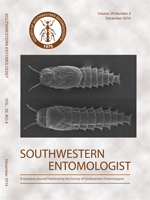Ornamental horticulture is the commercial exploitation of fresh or preserved species that satisfy the visual tastes of consumers. This report compares the alpha and beta diversity associated with the myrmecofauna of ornamental crops of zingiberaceae, heliconias, and palms with different agricultural management practices and a remnant of forest in Ixtaczoquitlán, Veracruz, Mexico. A total of 965 ant workers belonging to 37 species, 25 genera, 16 tribes, and seven subfamilies was collected. Richness, diversity and evenness of species decreased significantly as the degree of management and agricultural intensification increased. The myrmecofauna composition from the forest was significantly different from that found in the three ornamental crops. The impact of ornamental horticulture on biodiversity may be due to farm management. Excessive use of agrochemicals generates local loss of species diversity. Ornamental crops with low intensification of agricultural management could represent a habitat that offers resources and conditions to different ant guilds and other invertebrates.
How to translate text using browser tools
1 December 2014
Myrmecofauna from Three Ornamental Agroecosystems with Different Management and a Forest Remnant in Ixtaczoquitlán, Veracruz, Mexico
Ivonne Landero-Torres,
Iván Madrid-Ñeco,
Jorge E. Valenzuela-González,
Maria Elena Galindo-Tovar,
Otto Raúl Leyva-Ovalle,
Joaquín Murguía-González,
Hilda Eulalia Lee-Espinosa,
Miguel Á. Garcia-Martinez
ACCESS THE FULL ARTICLE

Southwestern Entomologist
Vol. 39 • No. 4
December 2014
Vol. 39 • No. 4
December 2014




